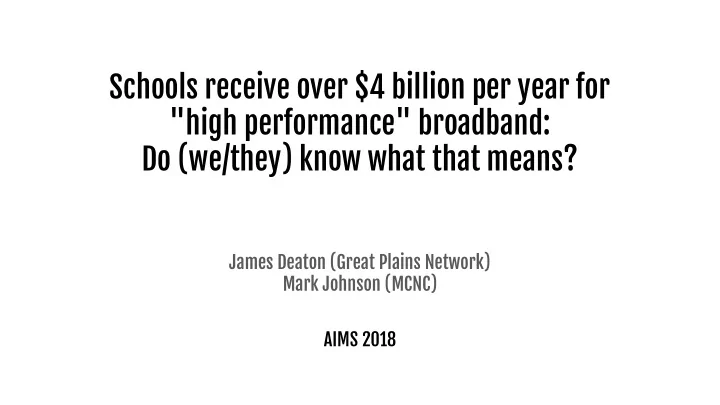

Schools receive over $4 billion per year for "high performance" broadband: Do (we/they) know what that means? James Deaton (Great Plains Network) Mark Johnson (MCNC) AIMS 2018
Background 1996 Telecommunications Act established foundation for E-Rate ● Administered by the Universal Service Administration Corporation (USAC) ● Reimburses a discounted portion of the total cost of Internet, WAN, and managed ● internal broadband services for schools and libraries Began distributing funding in 1998 ● Often matched by state-based programs covering portions of the unreimbursed ● amounts An open API for USAC E-rate data is finally available
Background State Educational Technology Directors Association (SETDA) published a report in 2012 establishing recommendations for bandwidth per student FCC E-Rate Modernization Orders of 2014 adopts SETDA numbers as a bandwidth target Education Superhighway embraced and popularized this concept in ESH's State of the States Report with engagement directly with Governors
Background https://upgrade.educationsuperhighway.org/types-of-fiber-services/k-12-bandwidth-targets/
Background In September 2016, the State Educational Technology Directors Association (SETDA) released “The Broadband Imperative II: Equitable Access for Learning.” Small School District (Fewer than 1,000 students) ● At least 1.5 Mbps per user (100 Mbps minimum for district) by 2017-18 ○ At least 4.3 Mbps per user (300 Mbps minimum for district) by 2020-21 ○ Medium School District (3,000 students) ● At least 1 Gbps per 1,000 users by 2017-18 ○ At least 3 Gbps per 1,000 users by 2020-21 ○ Large School District (More than 10,000 students) ● At least 0.7 Gbps per 1,000 users by 2017-18 ○ At least 2.0 Gbps per 1,000 users by 2020-21 ○
Current State Broadband now critical to schools and used for administrative purposes, testing, course management, course content Bandwidth per student, dollars per megabit, special construction, and managed wireless are directing funding practices but experience at the schools often falls short in being able to qualify what the schools are receiving Spotty attempts to measure capacity with opaque methods and little, if any raw data
Infrastructure Influenced By FCC Modernization Order Typical building architecture: Typical district connection architecture Wired to building, wireless to users (outside of building)
District-level measurements Weekly utilization cycle Weekends visible Consuming vs providing workday-only Yearly utilization cycle Summer, Christmas, spring breaks visible Typical growth from spring to fall
https://www2.mcnc.org/ncren/portal/reporting/ncren_utilization_map
NC K12 traffic growth 2011-2017 Gbps 2011 2017
Sample data on WiFi deployment in North Carolina Can we correlate this to performance?
Measurement Issues Collecting and maintaining reliable active measurements Software approaches have often defaulted to having some administrator run speed test software on ● desktop machine of unknown capability at unknown and inconsistent times Little effort has been made to measure at the wireless user or compare that to edge of building ● Passive measurement introduces privacy concerns. Very little data on application performance ● (QoE) A mix of application types with different user bases, requirements, expectations E.g. Business administration, course administration, course content, standardized testing
Possible approaches Introduce hardware appliance http://projectbismark.net/ - focused on home use, reprogrammed home routers http://perfclub.org/ - university research use, Raspberry PI devices https://www.samknows.com/ - FCC sponsored home use measurement https://atlas.ripe.net/ - European measurement, purpose-built devices Need to define methods (traffic type, frequency, location of appliance, etc) Carefully choose test destination endpoints to ensure consistency Endpoint selection must consider that the majority of traffic for many schools are sourced from cloud providers ● like Google and Amazon Backend data store, schema Base level visualization Important philosophy All data and methods should be open
Unresolved Issues What are appropriate QoE measurements? When, Where and How should measurement occur? How do we use the measurements to drive policy? What is the best way to communicate measurement results? Current experience suggests policy makers don’t want much (any?) complexity or nuance
Recommend
More recommend